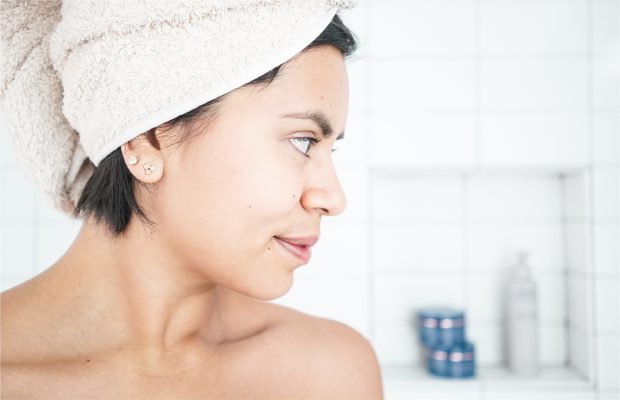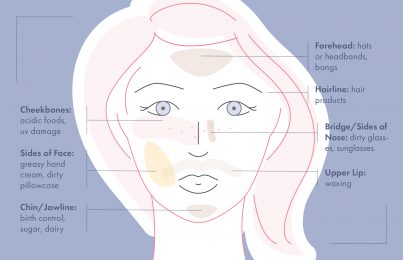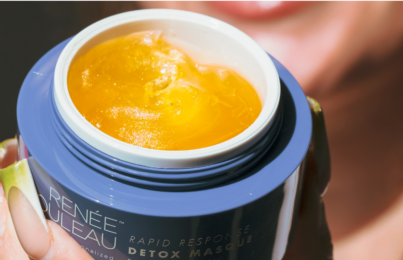When I was a teenager, I suffered from terrible back breakouts. Sure, I would get the occasional breakout on my face and around my hairline (this would worsen in my 20s), but most of my breakouts appeared on my back. To make matters worse, they were mostly cystic breakouts—those hard, sore, underground bumps that take weeks to go away.
I visited a dermatologist who gave me oral antibiotics and topical benzoyl peroxide to use on my back. The combination helped lessen the breakouts, but I was left with dry, itchy skin. That’s not to mention my bleached clothing from the peroxide.
Body acne, whether it be on the back, neck, or chest, can be frustrating to address. The good news is that we’ve come a long way from relying on antibiotics and drying topical creams. In this post, I’ll share the advice I wish I knew back when I was dealing with my own back breakouts.
What Exactly Is Body Acne?
Body breakouts are fundamentally the same as those that develop on the face. They can be challenging to address because they cover a larger area of the body (and they’re often located in hard-to-reach spots). Body breakouts occur as a result of overactive oil glands and blocked pores. This creates an environment in which “bad” bacteria can thrive and cause those red, inflamed bumps we know all too well.
It normally develops on the back and chest, because the skin is thicker, and both areas have an abundance of sebaceous glands that produce oil. It can also sometimes be found on the arms, but it’s generally not found on the lower body.
When it comes to back and chest breakouts specifically, you’ll likely see larger pustules, which are inflamed red spots with a “whitehead,” or cysts, which are often painful bumps that form deep under the skin and never come to a head. It’s important to refrain from picking cystic blemishes since the body usually reabsorbs them from within. Picking won’t make the blemish go away any faster and could result in long-lasting damage to the skin in the form of hyperpigmentation (AKA post-breakout scars).
What Are the Possible Causes of Body Acne?
As is the case with most breakouts, the biggest trigger for body breakouts is hormones. Stress can also be a trigger since it encourages the production of androgens—a group of hormones that can stimulate oil production.
Breakouts on the back and chest can be exacerbated by tight-fitting clothing, especially when that clothing is worn during sweaty workouts. The same goes for athletic equipment such as football pads (this is especially common in teens).
10 Ways to Minimize and Prevent Body Acne
1. Avoid Tight-Fitting Clothing
Body acne can’t always be completely avoided, but it’s still a good idea to break habits that could be contributing to it. Tight-fitting clothing, particularly tight-fitting workout gear, could be a trigger. Clothes that trap heat and moisture against the body for prolonged periods of time and/or create friction should be avoided. Opt for loose-fitting clothes instead.
Read how to care for your skin when working out.
2. Clean Your Bedsheets Weekly
When someone struggles with breakouts on their face, I usually tell them to be diligent about changing their pillowcases to avoid reintroducing oil, dirt, and bacteria to their skin. The same concept applies to the body. Regularly cleaning your sheets may minimize oil buildup.
3. Opt for Sun-Protective Clothing
Sunscreen is important, but it’s also tricky since so many formulas are notorious for exacerbating breakouts. This is especially true for waterproof formulas that are applied to the back and body. That’s why I recommend opting for sun-protective clothing if possible. Be sure to choose clothing with a UPF rating (which is essentially SPF for clothing).
4. Shower Often
People who are prone to body breakouts are those who produce excess oil, and generally speaking, those who have oily skin on their face will also have oily skin on their back and chests. Since oil is a breeding ground for bacteria, one of the ways to reduce breakouts is to shower often—as often as twice a day if it’s hot out. Trust me, keeping the skin clean can make a huge difference.
I also recommend showering as soon as possible after working out. While sweat doesn’t technically cause acne, it can create an occlusive environment and disrupt the normal flow of oil within the pore. If you can’t shower immediately after working out, apply a cleanser to a damp washcloth and wipe it over the affected area.
5. Use a Pore-Clearing Cleanser
Every time you shower, I suggest using a pore-clearing cleanser to clean the skin, remove oils, and reduce the number of “bad” surface bacteria that are present. It can be difficult to find a body cleanser that fits the bill, so I actually prefer using a facial cleanser, instead. Look for one that’s formulated for blemish-prone skin types, is sulfate-free, and uses salicylic acid, like the AHA/BHA Blemish Control Cleanser.
6. Switch Out Your Hair Conditioner
Conditioners are often formulated with heavy, oil-soluble ingredients. These ingredients work as occlusives. In fact, many of them are actually designed to coat and stick to the hair, so they may do the same to the skin as well. If they don’t rinse off the skin, they could clog pores and encourage breakouts to form. That’s why I always recommend switching out your conditioner to see if it affects your skin.
I’ve suggested this to clients for years, and over time, I’ve received tremendous feedback. So many of them have told me how switching conditioners made a drastic difference in the state of their skin. Trust me—it’s worth a shot!
Read could hair conditioner be causing your skin to break out?
7. Be Sure to Exfoliate
Dead skin cells can clog pores, so it’s crucial to gently remove buildup by exfoliating every time you shower. If back breakouts are your concern, it can be hard to reach certain areas. That’s why I made the Back & Body Buffing Towel to be 4′ x 1′, the ideal length for those hard-to-reach areas. This quick-dry towel is a great alternative to loofahs, which can be a breeding ground for bacteria, as well as messy body scrubs. A bit of physical exfoliation will help slough off dead skin cells that have been loosened by exfoliating acids (more on that in a second). Just be sure to use light pressure to avoid causing unnecessary redness or sensitivity.
As for the exfoliating acid I recommend, it’s without a doubt salicylic acid. Salicylic acid can help prevent new breakouts and even address discoloration from old breakouts. Apply a salicylic acid serum, like the BHA Clarifying Serum, twice a week for best results.
8. Apply a Spot Treatment When Necessary
Body breakouts tend to be rooted deep in the skin. The infection often won’t come to the surface, so you’ll want to choose a spot treatment carefully. Look for something like Anti Bump Solution that doesn’t focus on drying a blemish out. If a blemish is not on the skin’s surface, drying it out will only make matters worse.
Applying a drying spot treatment can only be helpful if you have blemishes that come to a whitehead. If you aren’t having much luck with spot treatments, benzoyl peroxide could be worth a shot. Using it as a spot treatment will prevent unnecessary dryness.
Read most spot treatments don’t work, but here’s what will.
9. Consult a Professional
The suggestions I’ve shared so far are great to do at home. However, if you’re still struggling and have yet to see results, schedule an appointment with a professional, like an esthetician. They can help you develop a personalized treatment plan and give you expert advice.
One thing I want to note is that many spas offer back facials. These are specially designed to clean out clogged pores. This might be something worth considering!
10. Use Medication if Necessary
If you’ve been diligent about caring for your skin in all of the ways I’ve described, including seeking professional help, then it’s time to consult a dermatologist. They may suggest antibiotics or a topical retinoid. There are also medications that can directly address hormonal imbalances that may be causing your body acne.
Celebrity Esthetician & Skincare Expert
As an esthetician trained in cosmetic chemistry, Renée Rouleau has spent 35 years researching skin, educating her audience, and building an award-winning line of products. Her hands-on experience as an esthetician and trusted skin care expert has created a real-world solution — products that are formulated for nine different types of skin so your face will get exactly what it needs to look and feel its best. Trusted by celebrities, editors, bloggers, and skincare obsessives around the globe, her vast real-world knowledge and constant research are why Marie Claire calls her “the most passionate skin practitioner we know.”




Comments:
I found How to Get Rid of Body Acne on Your Back and Chest very informative and practical. The emphasis on natural remedies and holistic approaches is refreshing. A must-read for anyone struggling with body acne. Thanks for sharing!
Posted By: Dr.Tina's Skin Solutionz |